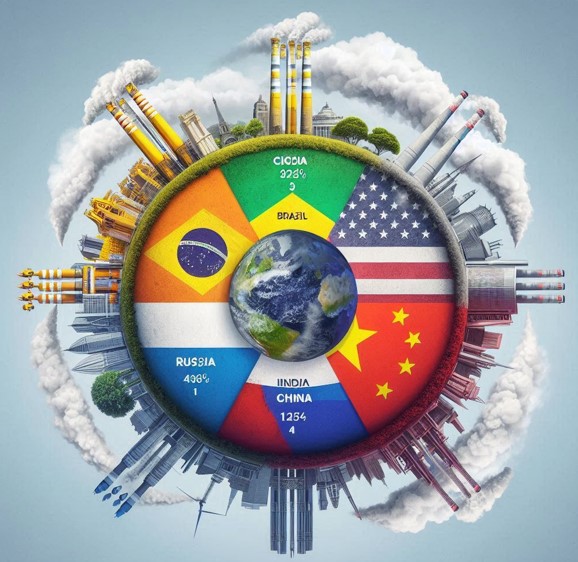The Top 5 -Countries By Emissions And Their Plans

Despite world leaders claiming that they’re making efforts to go green, the temperature’s still rising. Certain parts of New Delhi, India recently hit 52 degrees during the recent heatwave, something which could easily kill those living without shelter. While change does take time to come, it shouldn’t have taken this long. Today, we’ll be taking a look at the top 5 regions that likely caused things to get this bad and their efforts in renewable energy which will signal whether they’re going to be responsible if things get worse.
5)Brazil
Fostering a population of 217 million and emitting 1.8 GTeqCO2, the south American country makes up 2.44% of the world’s total greenhouse gas emissions. Unlike other countries however, a major part-nearly 78% comes from beef production, including emissions linked with deforestation for livestock farming and pollution from beef packing plants. Ranked alongside countries, Brazil’s beef industry with its 205 million cows alone would be the world’s seventh-largest greenhouse gas emitter, ahead of major economies such as Japan.
So, what steps is Brazil taking to offset their massive footprint?
While Brazil hasn’t committed to reduce or limit its anthropogenic emissions of greenhouse gases, the various programmes being held have resulted in a considerable reduction of greenhouse gas emissions. One successful example is the Motor Vehicle Air Pollution Control Programme, which led to Brazil being the first country in the world to get rid of tetraethyl lead from gasoline. Average emissions for cars have gone down as a result of this programme.
It’s not all sunshine and rainbows though, as the government does not seem to be making too many efforts despite their pledge at the climate summit. The amazon rainforest continues to be cut down to develop more areas and the environment budget continues to shrink. President Jair Bolsonaro approved a cut to the environment ministry budget a day after he vowed to boost spending to tackle deforestation. Brazil may emit 2.5 billion tons of carbon dioxide as early as 2030.
Despite high emissions, Brazil doesn’t seem to be falling behind in the renewable energy sector. As of 2023, nearly 93% of Brazil’s power generation came from renewable sources, with hydropower contributing more than half. Brazil has done its homework when it comes to energy generation after all.
4) Russia
Despite information on greenhouse gas emissions being relatively sparse due to the war in Ukraine, Russia’s estimated greenhouse gas emissions sit somewhere around 2.5 billion CO2 equivalent tons a year, nearly doubling that of Brazil. Annual carbon dioxide emissions alone sit around 12 tons per person, more than double the world average.
The country is the world’s largest methane emitter, with an estimated 4-billion-dollar leak in 2019/2020.
According to Russian authorities, hydroelectricity contributes to nearly 16.0% of Russia’s total electricity generation. Independent reports from BP suggest otherwise, putting renewables at just 0.05% of the nation’s overall electricity generation in 2015. As of 2020, the renewables share of primary energy consumption is only 0.1%.
Russia aims to reach net zero by 2060, but its energy strategy till 2035 mostly involves burning more fossil fuels.
3)India
Home to the world’s fastest growing population, India emits 3.9 billion carbon equivalent tons every year, making up for 7.33% of the world total. Being the largest developing nation in the world, India consumes a lot of energy, with most of it going to industrial usage. India’s high emissions can be attributed to its massive population, with the emission per capita being extremely low, at 1.612 tonnes per capita. The emission rates have been increasing steadily, at about 5% per year.
The main source of GHG emissions in India is electricity generation via coal burning. Fossil fuels are required by the country still, a result of the rapid industrialization and high energy demands caused by it. Old coal-fired plants are used, with few new ones likely to be built.
Looking at renewables, India’s numbers are nothing to scoff at. The 3rd largest renewable energy producer in the world, over 40% of India’s energy capacity-180 GW came from renewables in 2023. India has additionally committed for a goal of 500 GW renewable energy capacity by 2030. Additionally, India ranks 5th globally for installed hydroelectric power capacity
2)USA
The land of the free is the first on our list to hit double digits in terms of contribution, with 6 billion carbon equivalent tons contributing to 11.19% of the total greenhouse gas emissions on earth. The average person in America emits 15 tonnes of greenhouse gas per year, nearly 3 times the global average.
USA’s energy related CO2 emissions decreased by 3% in 2023, amounting to a reduction of approximately 134 million metric tons. This was due to a shift from coal-fired power to more sustainable sources like solar and natural gas. As of 2023, the largest source of greenhouse gas emissions in the country remains the transportation sector, which can be attributed to the overabundance of car-reliant infrastructure.
As of 2022, renewable energy in the US has surpassed coal, generating 20% of the country’s power requirements. 10% of this comes from wind turbines, with hydropower and solar at 6% and 3.4% respectively. By 2025, domestic solar energy generation is expected to increase by 75%, and wind by 11%. The US has a renewable capacity of 388 gigawatts.
The US has joined 115 nations in pledging to double energy efficiency and triple renewable energy capacity by 2030.
1) China
Above everyone in all statistics, the formerly most populated country in the world emits 15.6 billion tonnes of greenhouse gases per year, equivalent to two USAs and the entirety of the European Union. Making up 29% of the world’s total greenhouse emissions, coming mainly from coal burning and blast furnaces producing iron and steel. Chinese state coal production alone accounts for 14% of historic global emissions. China’s per person emissions have remained considerably lower than those in the developed world, at 10.1 tons CO2eq per person.
China has committed to peak emissions by 2030 and net zero by 2060, promising to phase down coal use from 2026. While China is estimated to achieve its renewable energy capacity and emission reduction goals early, limiting warming to 1.5 degrees will require further planning and efforts.
As of 2024, China recorded a 3% decrease in greenhouse gas emissions year by year. The reduction was largely attributed to an expansion in wind and solar power capacities, which largely covered the increased demand for electricity, coupled with a downturn in the property sector that resulted in lower emissions from industries like steel and cement manufacturing.
Part of the pledge to triple renewable energy capacity by 2030, China has been investing heavily into solar. In 2022, China reportedly installed as much solar capacity as the rest of the world combined, which it doubled in 2023. Wind capacity was increased by 66% and energy storage was nearly quadrupled. China has made strategic investments in all aspects of renewable technologies, from solar and wind capacity, green hydrogen, and geothermal projects to research and investment in battery storage and its supply chains. Overall, the country is doing all the heavy lifting and then some, accounting for 80% of the world’s renewable manufacturing capacity.
By Yash Singh




